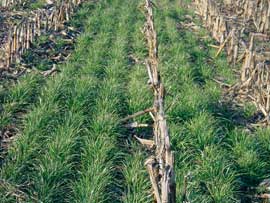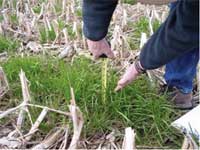Benefits of Annual Ryegrass
Dan Towery, Ag Conservation Solutions
(Also check out this 2017 article in No Till Farmer article: Increase Your ROI with Cover Crops)
Annual Ryegrass, when used as a cover crop in the Midwest, can satisfy numerous farm objectives for growers:
Drought Resistance
 Natural hardpan (fraigpan) or manmade compaction prevent corn and soybean roots from getting deep moisture. These soils are found predominately in southern Ohio, Indiana, Illinois, Kentucky and Missouri. Annual Ryegrass grows through and breaks up hardpan, creating macropore channels that corn and soybean roots follow to reach moisture underneath. It will take approximately 4 years (4-6” fraigpan) of continuous no-till with annual ryegrass each year to achieve this. Planting Annual Ryegrass for as little as 2 years in a row may be as effective as running a ripper. In the long run, a cover crop and no-till is a far better strategy for improving soil health and crop yields than conventional tillage.
Natural hardpan (fraigpan) or manmade compaction prevent corn and soybean roots from getting deep moisture. These soils are found predominately in southern Ohio, Indiana, Illinois, Kentucky and Missouri. Annual Ryegrass grows through and breaks up hardpan, creating macropore channels that corn and soybean roots follow to reach moisture underneath. It will take approximately 4 years (4-6” fraigpan) of continuous no-till with annual ryegrass each year to achieve this. Planting Annual Ryegrass for as little as 2 years in a row may be as effective as running a ripper. In the long run, a cover crop and no-till is a far better strategy for improving soil health and crop yields than conventional tillage.
Who benefits? Growers who combine no-till and cover crops outproduce those still clinging to the old ways (conventional tillage.)
Erosion Control
Annual Ryegrass provides quick ground cover and erosion control after harvesting corn silage or seed corn. The earlier harvest and lack of residue makes these good candidates for use of Annual Ryegrass.
Nutrient Recycling
 The high price of nitrogen has growers looking for ways to be more efficient. Using Annual Ryegrass may provide 60-80 lbs/ac of nitrogen. This alone could more than pay for the cost of the seed and planting it. In addition, after several more years, Phosphorus may become available as P2 is transformed to P1 in the soil.
The high price of nitrogen has growers looking for ways to be more efficient. Using Annual Ryegrass may provide 60-80 lbs/ac of nitrogen. This alone could more than pay for the cost of the seed and planting it. In addition, after several more years, Phosphorus may become available as P2 is transformed to P1 in the soil.
Nitrogen Recovery
Growers applying manure are being required to apply manure in a more environmentally friendly fashion. Using Annual Ryegrass could help keep the nitrogen in the soil profile and available for the crop the following year.
Soil Improvement
In addition to improving fertility, Annual Ryegrass produces biomass that will increase the soil organic matter and fertility after the cover crop is burned down in the spring.
Quicker Transition to No-Till
When a grower changes to no-till or acquires a farm that is new to no-till, it commonly takes up to 5 years for key soil properties (aggregate stability, organic matter, increased infiltration, pore space, fungi, etc) to occur. Adding Annual Ryegrass can reduce this transition period by half.
Weed Suppression
Annual Ryegrass is a vigorous seedling that quickly forms a cover to compete with winter annual weeds.
Increased Water Infiltration
The extensive and deep root system that Annual Ryegrass develops opens pathways for increased water infiltration.
Soybean Cyst Control
Soybean cyst nematodes results in lower soybean yield. Research studies indicate that Annual Ryegrass can (with at least 40 days growing with the soil temperature about 50 degrees) stimulate cyst eggs to hatch in the fall. This results in a very low count, if not elimination, of the nematodes the following year. Fields in the southern half of Illinois, Indiana, Ohio, and Missouri are likely places to benefit, since odds are good that they satisfy the environmental conditions.
Grazing
Growers who plant after wheat or corn silage may be able to take a cutting of Annual Ryegrass haylage in the fall (possibly in the spring, too) and then no-till plant into the Annual Ryegrass. Growers in southern Ohio, Indiana Illinois, Kentucky and Missouri may be able to graze the Annual Ryegrass over winter or take a cutting of haylage in the spring.

Pingback: Annual Ryegrass – Deepest Rooting of any Cover Crop | Annual Ryegrass Cover Crop